Juno Spacecraft: What Do We Hope To Learn?
Juno Spacecraft: What Do We Hope to Learn?

The Juno spacecraft has been traveling toward its destination since its launch in 2011, and is set to insert Jupiter’s orbit on July 4. Jupiter is by far the largest planet in the solar system. Humans have been studying it for hundreds of years, yet still many basic questions about the gas world remain.

The primary goal of the Juno spacecraft is to reveal the story of the formation and evolution of the planet Jupiter. Understanding the origin and evolution of Jupiter can provide the knowledge needed to help us understand the origin of our solar system and planetary systems around other stars.

Have We Visited Jupiter Before? Yes! In 1995, our Galileo mission (artist illustration above) made the voyage to Jupiter. One of its jobs was to drop a probe into Jupiter’s atmosphere. The data showed us that the composition was different than scientists thought, indicating that our theories of planetary formation were wrong.
What’s Different About This Visit? The Juno spacecraft will, for the first time, see below Jupiter’s dense clover of clouds. [Bonus Fact: This is why the mission was named after the Roman goddess, who was Jupiter’s wife, and who could also see through the clouds.]

Unlocking Jupiter’s Secrets
Specifically, Juno will…
Determine how much water is in Jupiter’s atmosphere, which helps determine which planet formation theory is correct (or if new theories are needed)
Look deep into Jupiter’s atmosphere to measure composition, temperature, cloud motions and other properties
Map Jupiter’s magnetic and gravity fields, revealing the planet’s deep structure
Explore and study Jupiter’s magnetosphere near the planet’s poles, especially the auroras – Jupiter’s northern and southern lights – providing new insights about how the planet’s enormous
Juno will let us take a giant step forward in our understanding of how giant planets form and the role these titans played in putting together the rest of the solar system.
For updates on the Juno mission, follow the spacecraft on Facebook, Twitter, YouTube and Tumblr.
Make sure to follow us on Tumblr for your regular dose of space: http://nasa.tumblr.com
More Posts from Carlosalberthreis and Others
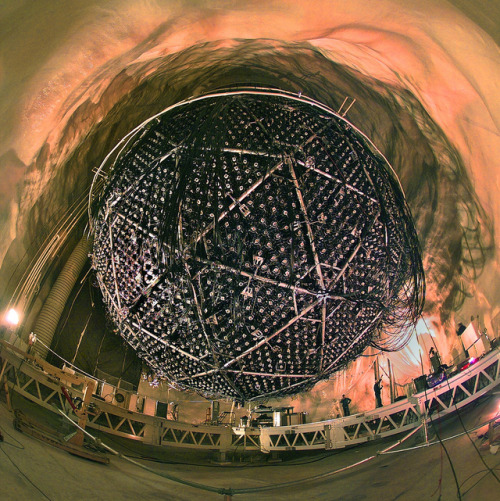
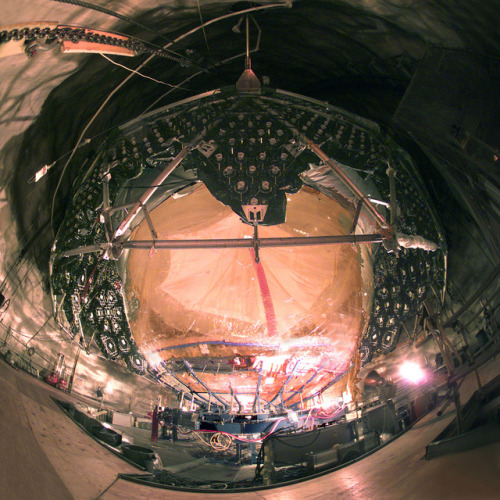

The Sudbury Neutrino Observatory (SNO)
Located in a cave more than a mile underground in Canada, SNO can be thought of as a type of telescope, though it bears little resemblance to the image most people associate with that word. It consists of an 18-meters-in-diameter stainless steel geodesic sphere inside of which is an acrylic vessel filled with 1000 tons of heavy water (deuterium oxide or D2O). Attached to the sphere are 9,522 ultra-sensitive light-sensors called photomultiplier tubes. When neutrinos passing through the heavy water interact with deuterium nuclei, flashes of light, called Cerenkov radiation, are emitted. The photomultiplier tubes detect these light flashes and convert them into electronic signals that scientists can analyze for the presence of all three types of neutrinos.
Berkeley Lab
The Special Ingredients…of Earth!

With its blue skies, puffy white clouds, warm beaches and abundant life, planet Earth is a pretty special place. A quick survey of the solar system reveals nothing else like it. But how special is Earth, really?

One way to find out is to look for other worlds like ours elsewhere in the galaxy. Astronomers using our Kepler Space Telescope and other observatories have been doing just that!

In recent years they’ve been finding other planets increasingly similar to Earth, but still none that appear as hospitable as our home world. For those researchers, the search goes on.

Another group of researchers have taken on an entirely different approach. Instead of looking for Earth-like planets, they’ve been looking for Earth-like ingredients. Consider the following:

Our planet is rich in elements such as carbon, oxygen, iron, magnesium, silicon and sulfur…the stuff of rocks, air, oceans and life. Are these elements widespread elsewhere in the universe?

To find out, a team of astronomers led by the Japanese Aerospace Exploration Agency (JAXA), with our participation, used Suzaku. This Japanese X-ray satellite was used to survey a cluster of galaxies located in the direction of the constellation Virgo.

The Virgo cluster is a massive swarm of more than 2,000 galaxies, many similar in appearance to our own Milky Way, located about 54 million light years away. The space between the member galaxies is filled with a diffuse gas, so hot that it glows in X-rays. Instruments onboard Suzaku were able to look at that gas and determine which elements it’s made of.

Reporting their findings in the Astrophysical Journal Letters, they reported findings of iron, magnesium, silicon and sulfur throughout the Virgo galaxy cluster. The elemental ratios are constant throughout the entire volume of the cluster, and roughly consistent with the composition of the sun and most of the stars in our own galaxy.

When the Universe was born in the Big Bang 13.8 billon years ago, elements heavier than carbon were rare. These elements are present today, mainly because of supernova explosions.

Massive stars cook elements such as, carbon, oxygen, iron, magnesium, silicon and sulfur in their hot cores and then spew them far and wide when the stars explode.

According to the observations of Suzaku, the ingredients for making sun-like stars and Earth-like planets have been scattered far and wide by these explosions. Indeed, they appear to be widespread in the cosmos. The elements so important to life on Earth are available on average and in similar relative proportions throughout the bulk of the universe. In other words, the chemical requirements for life are common.

Earth is still special, but according to Suzaku, there might be other special places too. Suzaku recently completed its highly successful mission.
Make sure to follow us on Tumblr for your regular dose of space: http://nasa.tumblr.com
Mais um vídeo do antigo canal!!!
O rover Curiosity acabou de completar dois anos explorando de maneira bem sucedida Marte. Desde que chegou ao planeta vermelho o rover não é mais o mesmo, tem enfrentado o clima e o ambiente hostil de Marte com muita garra e energia, sua carroceria, já não é mais tão limpa, está todo arranhado e com marcas de sua exploração por todo lado. Mas são as marcas, ou melhor as cicatrizes encontradas nas rodas do rover é que têm chamado a atenção dos cientistas e de todos aqueles envolvidos na missão.
Os cientistas da NASA ficaram alarmados ao notar um buraco, muito maior daquele esperado, em uma das seis rodas do rover, no Sol 411, ou seja, no dia de trabalho na superfície marciana, de número 411. Cada Sol dura aproximadamente 24h39m.
De início o furo foi tratado como uma anormalidade sem consequência, mas no Sol 463, uma nova inspeção nas rodas revelou um rasgo ainda maior.
“Quando vimos essas imagens, vimos um buraco que era bem maior do que esperávamos. Não se encaixava a nada que havíamos visto em nossos testes. Não sabíamos o que o estava causando”, conta Matt Haverly, piloto do rover no JPL da NASA . A descoberta desse rasgo levou a novos testes, na Terra e em Marte, para descobrir o que estava acontecendo. Então os engenheiros constataram que os furos estavam sendo produzidos por rochas pontiagudas que, por estarem fixadas firmemente ao solo, ou seja, eram rochas do embasamento, não se deslocavam ao encontrar as rodas.
Além disso, um problema adicional era responsável pelos rasgos, a fadiga do material.
As rodas do Curiosity são feitas de uma fina camada de alumínio, com 0.75 mm de espessura. Ao evoluírem sobre o terreno marciano, elas se distorcem levemente, em função do peso do rover e da dureza do solo.
Esse processo acaba deixando o material quebradiço, como quando você torce um clipe de papel metálico para um lado e para o outro até que ele se quebra, explica Emily Lakdawalla, cientista, e blogueira da ONG Planetary Society e que publicou um belo e extenso relatório sobre os problemas encontrados pelo rover Curiosity em sua jornada no Planeta Vermelho.
Em resumo, as rodas do Curiosity estão lentamente se esfacelando pelo caminho.
Até agora, não houve uma perda de desempenho considerável na condução do rover. As rodas, apesar das perfurações, mantêm sua forma original e avançam bem sobre qualquer tipo de terreno. Contudo, para evitar um desgaste acelerado, os pilotos do rover têm optado por seguir rotas que pareçam oferecer menos rico. Isso pode limitar a escolha de alvos científicos. Além disso, por vezes eles têm conduzido o rover de ré, para reduzir o desgaste nas rodas frontais.
Testes agressivos feitos no deserto de Mojave, na Califórnia, mostram que, nas piores condições de terreno possíveis, com solo duro e repleto de rochas, as rodas podem ser inutilizadas após 8 km. Até agora o rover rodou por 9 km na superfície acidentada do interior da Cratera Gale em Marte.
Num terreno fofo e com poucas rochas, ele poderia avançar indefinidamente. Mas o potencial para descobertas, nesse caso, também seria drasticamente reduzido.
Tentando encontrar um equilíbrio entre a ciência e a engenharia, os gerentes da missão imaginam que o Curiosity possa ainda andar bem em Marte. Mas será difícil bater o recorde de seu antecessor, o rover Opportunity, que já está a uma década em Marte, e já percorreu mais de 40 km.
Para o próximo rover, a missão Marte 2020, a ideia é mudar o design das rodas, e, com isso, impedir a repetição do problema. Também cresce a pressão para que o planejamento seja mais criterioso na escolha do local de pouso, exigindo pouca rodagem até alvos científicos de alto interesse.
No vídeo acima eu debato e discuto esse tema, apresentando as principais características das rodas do rover, a razão para os seus problemas e o que se tem pensado de solução.
Mais uma vez, se gostarem do vídeo, deixem o “joinha”, se inscrevam no canal, favoritem o vídeo, compartilhem nas redes sociais e deixem seus comentários, tudo isso ajuda na divulgação e nos dá motivação para continuarmos gravando e postando vídeos sobre astronomia, astrofísica e astronáutica, para todos vocês.
(via https://www.youtube.com/watch?v=taQSA94xa18)
More Than Just Drawings
Artist and graphic designer Mike Okuda may not be a household name, but you’re more familiar with his work than you know. Okuda’s artistic vision has left a mark here at NASA and on Star Trek. The series debuted 50 years ago in September 1966 and the distinctive lines and shapes of logos and ships that he created have etched their way into the minds of fans and inspired many.
Flight Ops

The Flight Operations patch has a lengthy history, the original version of which dates to the early 1970s. Having designed a version of the patch, Okuda had some insights about the evolution of the design.
“The original version of that emblem was designed around 1972 by Robert McCall and represented Mission Control. It later changed to Mission Operations. I did the 2004 version, incorporating the space station, and reflecting the long-term goals of returning to the Moon, then on to Mars and beyond. I later did a version intended to reflect the new generation of spacecraft that are succeeding the shuttle, and most recently the 2014 version reflecting the merger of Mission Operations with the Astronaut Office under the new banner Flight Operations.”
“The NASA logos and patches are an important part of NASA culture,” Okuda said. “They create a team identity and they focus pride on a mission.”

In July 2009, Okuda received the NASA Exceptional Public Service Medal, which is awarded to those who are not government employees, but have made exceptional contributions to NASA’s mission. Above, Okuda holds one of the mission patches he designed, this one for STS-125, the final servicing mission to the Hubble Space Telescope.
Orion

Among the other patches that Okuda has designed for us, it one for the Orion crew exploration vehicle. Orion is an integral of our Journey to Mars and is an advanced spacecraft that will take our astronauts deeper into the solar system than ever before.
Okuda’s vision of space can be seen in the Star Trek series through his futuristic set designs, a vision that came from his childhood fascination with the space program.
Learn more about Star Trek and NASA.
Make sure to follow us on Tumblr for your regular dose of space: http://nasa.tumblr.com

A cidade de Parintins está nos dias de festa religiosa, e então, resolvi relembrar a visita no local mais alto da torre da catedral, onde está localizado a estátua de Nossa Senhora do Carmo. #TorredaCatedraldeParintins Data de registro: 16 de julho de 2018 às 18h18

Feliz Natal! ⛪🎄
Que possamos seguir o exemplo da família de Jesus. Pois eles seguiram firmes diante das dificuldades da vida. 💚❤️
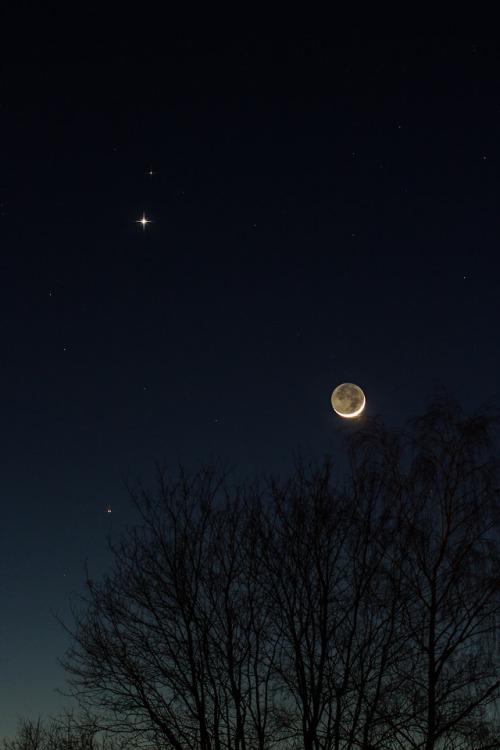
Conjunction: Mars, Venus and Moon
by Stefan Grießinger

Solar System: Things to Know This Week
Our solar system is huge, let us break it down for you. Here are a few things to know this week:
1. Juno Eyes on Jupiter

After a journey of more than five years, the Juno spacecraft is ready for its detailed look at Jupiter—arrival date: July 4. Using Eyes on the Solar System and data from the Juno flight team, you can take a virtual ride onboard the spacecraft in the “Eyes on Juno” simulation.
2. Taking a Spacecraft for a Spin
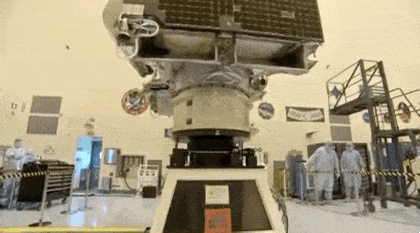
Preparations for the launch of the OSIRIS-REx asteroid mission are spinning up, literally. Here, the spacecraft can be seen rotating on a spin table during a weight and center of gravity verification test at our Kennedy Space Center. Liftoff is scheduled for Sept. 8. This spacecraft will travel to a near-Earth asteroid called Bennu and bring a small sample back to Earth for study.
3. Long-Range (Or at Least Long-Distance) Weather Report
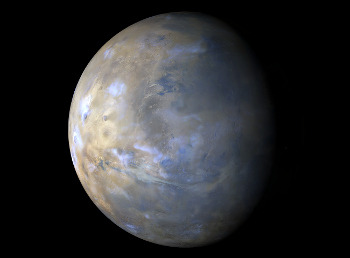
Our Mars Reconnaissance Orbiter acquires a global view of the red planet and its weather every day. Last week, dust storms continued along the south polar ice cap edge. Northern portions of Sirenum, Solis, and Noachis also experienced some local dust-lifting activity. A large dust storm propagated eastward over the plains of Arcadia at the beginning of the week, but subsided just a few days later over Acidalia.
4. Hello from the Dark Side

The New Horizons spacecraft took this stunning image of Pluto only a few minutes after closest approach in July 2015, with the sun on the other side of Pluto. Sunlight filters through Pluto’s complex atmospheric haze layers. Looking back at Pluto with images like this gives New Horizons scientists information about Pluto’s hazes and surface properties that they can’t get from images taken on approach.
5. A Titanic Encounter
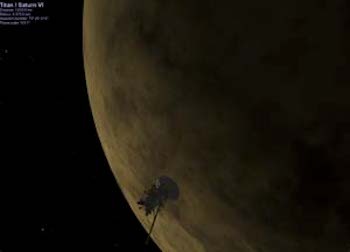
On June 7, our Cassini orbiter will fly very close by Saturn’s giant, haze-shrouded moon Titan. Among the targets of its observations will be the edge of the vortex that swirls in Titan’s thick atmosphere near its south pole.
Want to learn more? Read our full list of the 10 things to know this week about the solar system HERE.
Make sure to follow us on Tumblr for your regular dose of space: http://nasa.tumblr.com
-
 mercedesalma liked this · 1 year ago
mercedesalma liked this · 1 year ago -
 gqutie-blog liked this · 1 year ago
gqutie-blog liked this · 1 year ago -
 sonicsoundscapes liked this · 6 years ago
sonicsoundscapes liked this · 6 years ago -
 a-tractorman-world liked this · 6 years ago
a-tractorman-world liked this · 6 years ago -
 morby reblogged this · 6 years ago
morby reblogged this · 6 years ago -
 morby liked this · 6 years ago
morby liked this · 6 years ago -
 findlr1 liked this · 6 years ago
findlr1 liked this · 6 years ago -
 silviuai-blog liked this · 6 years ago
silviuai-blog liked this · 6 years ago -
 numberoneguy liked this · 7 years ago
numberoneguy liked this · 7 years ago -
 bumbumbumihatethesun liked this · 7 years ago
bumbumbumihatethesun liked this · 7 years ago -
 leppercolony liked this · 7 years ago
leppercolony liked this · 7 years ago -
 castcastle liked this · 7 years ago
castcastle liked this · 7 years ago -
 digipunk liked this · 7 years ago
digipunk liked this · 7 years ago -
 b0ggyb1tch liked this · 7 years ago
b0ggyb1tch liked this · 7 years ago -
 motherofdragonfire reblogged this · 7 years ago
motherofdragonfire reblogged this · 7 years ago -
 motherofdragonfire liked this · 7 years ago
motherofdragonfire liked this · 7 years ago -
 richard461220-blog liked this · 7 years ago
richard461220-blog liked this · 7 years ago -
 v1irus reblogged this · 7 years ago
v1irus reblogged this · 7 years ago -
 alphaneodesign liked this · 8 years ago
alphaneodesign liked this · 8 years ago -
 timallenphoto liked this · 8 years ago
timallenphoto liked this · 8 years ago -
 shininghyuck liked this · 8 years ago
shininghyuck liked this · 8 years ago -
 delta-m reblogged this · 8 years ago
delta-m reblogged this · 8 years ago -
 theshadowofmysoul7-blog reblogged this · 8 years ago
theshadowofmysoul7-blog reblogged this · 8 years ago -
 richiehellben-blog liked this · 8 years ago
richiehellben-blog liked this · 8 years ago -
 you-smell-like-poop reblogged this · 8 years ago
you-smell-like-poop reblogged this · 8 years ago -
 you-smell-like-poop liked this · 8 years ago
you-smell-like-poop liked this · 8 years ago -
 abaza54aba reblogged this · 8 years ago
abaza54aba reblogged this · 8 years ago -
 audrey-xoxo liked this · 8 years ago
audrey-xoxo liked this · 8 years ago -
 deadendpirate liked this · 8 years ago
deadendpirate liked this · 8 years ago -
 jupiterial liked this · 8 years ago
jupiterial liked this · 8 years ago -
 sarcastane reblogged this · 8 years ago
sarcastane reblogged this · 8 years ago -
 cyberdamner liked this · 8 years ago
cyberdamner liked this · 8 years ago

